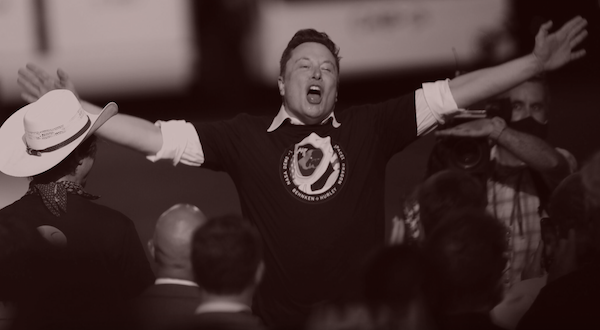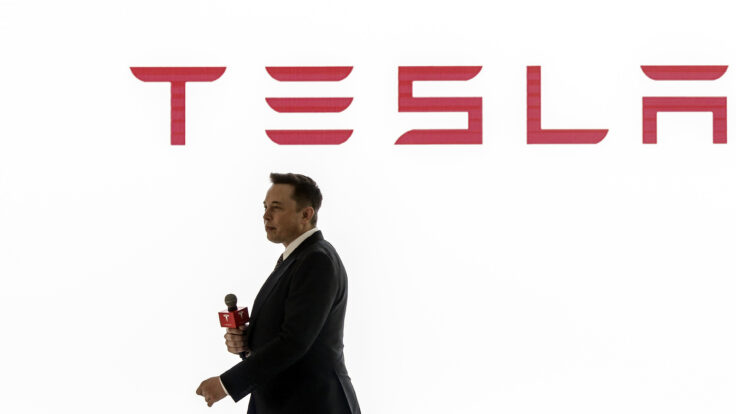|
Good evening, I'm William D. Cohan.
Welcome back to Dry Powder. Today, as promised, I'm taking a closer look at Tesla, the deliriously overvalued carmaker—seriously, it's now worth more than the nine largest carmakers combined—and its equally fantastical C.E.O., Elon Musk. Over the past several years, Tesla's uninhibited rise has broken the will of short-sellers, turning Musk into the wealthiest man in the world. As John Maynard Keynes famously said, “the markets can remain irrational longer than you can remain solvent.”
Then, of course, Musk logged onto Twitter, proffered a stock sale of $20 billion, and sent the company's valuation spiraling. Is the party finally over?
You can read a free preview of my latest reporting below, or sign up now to access the full story, delivered directly to your email.
Tesla has broken the will of short-sellers, market prognosticators, even one-eyed all-seeing Big Short god Michael Burry. But is the party finally ending? I first wrote about the Tesla enigma back in September 2018, during what we now know to be far more innocent times regarding speculation about the company and its valuation. This was shortly after Elon Musk tweeted that he wanted to take his company private for $420 a share and that he had “funding secured.” As it turned out, of course, Elon was just being Elon. He didn’t have the funding secured for the buyout, apparently had no intention of taking Tesla private, and may have violated securities laws in the process of suggesting to the market, as Tesla’s largest shareholder, that he was going to do something he had no intention of doing.
What made it all more bizarre, back then, was that Tesla was still something of a vision: a large, well-capitalized bet on the direction of the auto industry, the green economy, and a singularly brilliant founder. Tesla, after all, had never made any money from selling its electric cars and had some $11 billion of existing debt. The idea that Musk could take Tesla private by borrowing even more money without having the profits to repay that debt was just another one of Elon’s fantasies. Wall Street would never have provided the capital for that bit of financial folly. So suggesting the buyout was a really dumb idea at the time and it would never have been completed, even if Musk had been serious, which of course he wasn’t. (In the end, Musk paid the S.E.C. a wrist-slapping $20 million fine, stepped down as board chairman, and conceded that his Twitter feed would be vetted.) In my New York Times piece that day, I wondered at the outset: “Is it too late for Tesla?”
Well, while I may have been right about the possibility of Tesla going private in the summer of 2018, I was very wrong about the lengths investors would be willing to go to support the bildungsroman that is Tesla and Elon Musk. Don’t get me wrong. Tesla is now very real. It makes electric cars that people buy, and in droves, especially in Los Angeles, where every other car on the road seems to be a Tesla. And Elon Musk is real and it’s real that he is the world’s richest man with a net worth, depending on the nanosecond, of around $290 billion. (That is not a typo).
But what is not real—and what is not sustainable—is the logic for the company’s valuation. At $1 trillion, Tesla is now worth more than the entire auto industry combined plus, as Scott Galloway, the entrepreneur and N.Y.U. professor, recently put it to, “Boeing and Airbus and every specialty retailer on the planet.” (Musk recently called Galloway an “insufferable numbskull” on Twitter.) There simply is no justification for this valuation, not by any metric previously known to mankind, no matter how many times you adjust your EBITDA to try to make it look like Tesla is making enough money to justify that kind of valuation. As I have written before, the vast majority of the money that Tesla is making these days comes from selling “regulatory credits,” which Tesla sells to other companies so that they can comply with regulatory requirements.
Again, it’s not that Tesla isn’t selling cars, it’s just that Tesla isn’t making its profits from selling cars—at least not at the moment. In the first six months of 2021, Tesla sold 203,736 more cars than during the first six months of 2020, generating $8.8 billion in revenue. It’s worth noting, though, that 10 percent of Tesla’s revenue, or $872 million, came from selling carbon credits. Those regulatory credits are basically pure profit for Tesla and accounted for nearly half of its pre-tax profit, of $1.8 billion, in the first six months of 2021. In the last twelve months, ending June 2021, Tesla earned $2.166 billion, of which $1.67 billion, or 77 percent, came from selling carbon credits to other car manufacturers, not from selling cars...
FOUR STORIES WE'RE TALKING ABOUT As he works on the $43 billion Warner-Discovery merger, Zaslav seems to be all over town, and the subject of endless intrigue. MATT BELLONI Members of the intelligence community are increasingly convinced that the Russians are behind the terrifying directed-energy attacks on diplomats and spies causing "Havana Syndrome." JULIA IOFFE As global supply chains break down, the U.S. Department of Energy faces a political-economic crisis of its own making. PETER HAMBY Apollo has long been identified with its co-founder Leon Black. Now his successor Marc Rowan is on a mission to change that narrative. WILLIAM D. COHAN
|
-
Join Puck
Directly Supporting Authors
A new economic model in which writers are also partners in the business.
Personalized Subscriptions
Customize your settings to receive the newsletters you want from the authors you follow.
Stay in the Know
Connect directly with Puck talent through email and exclusive events.











